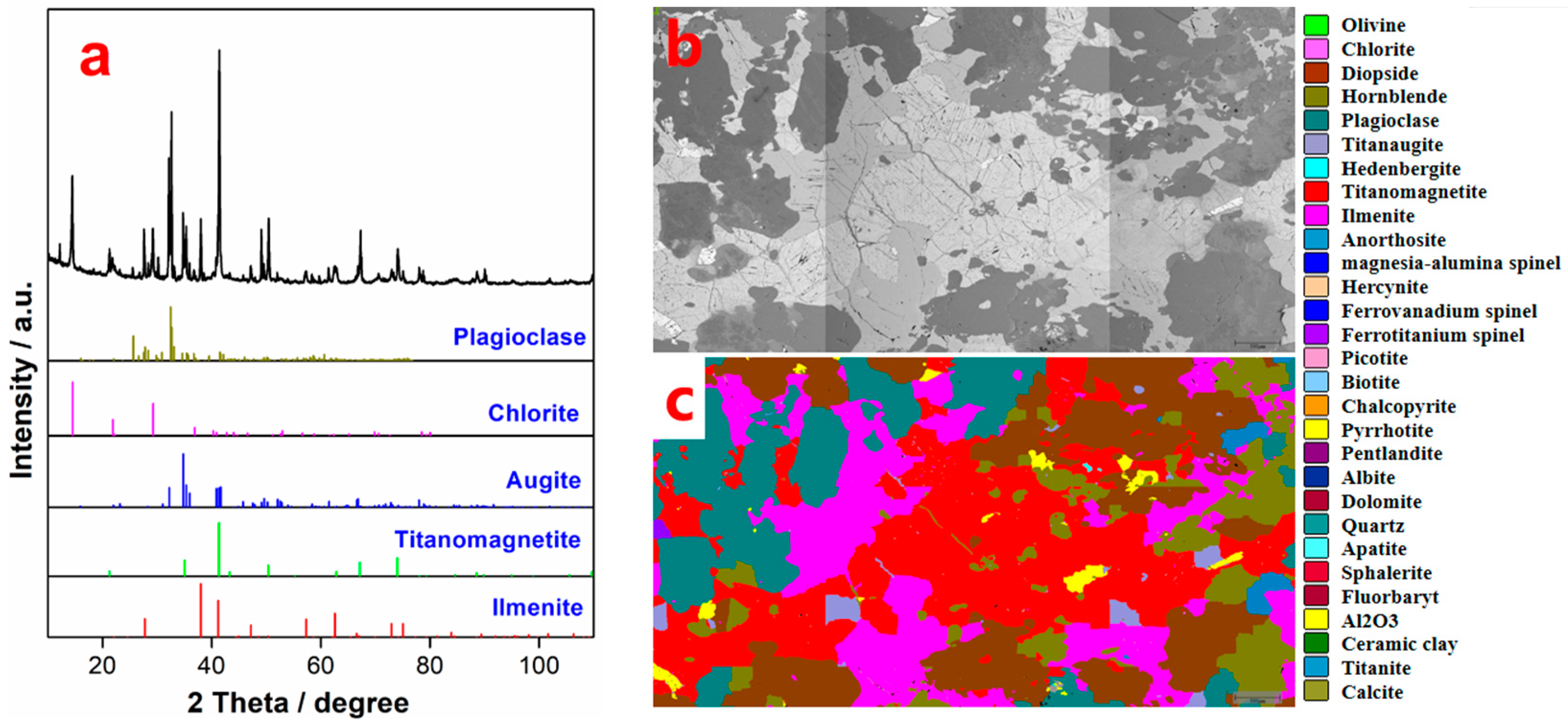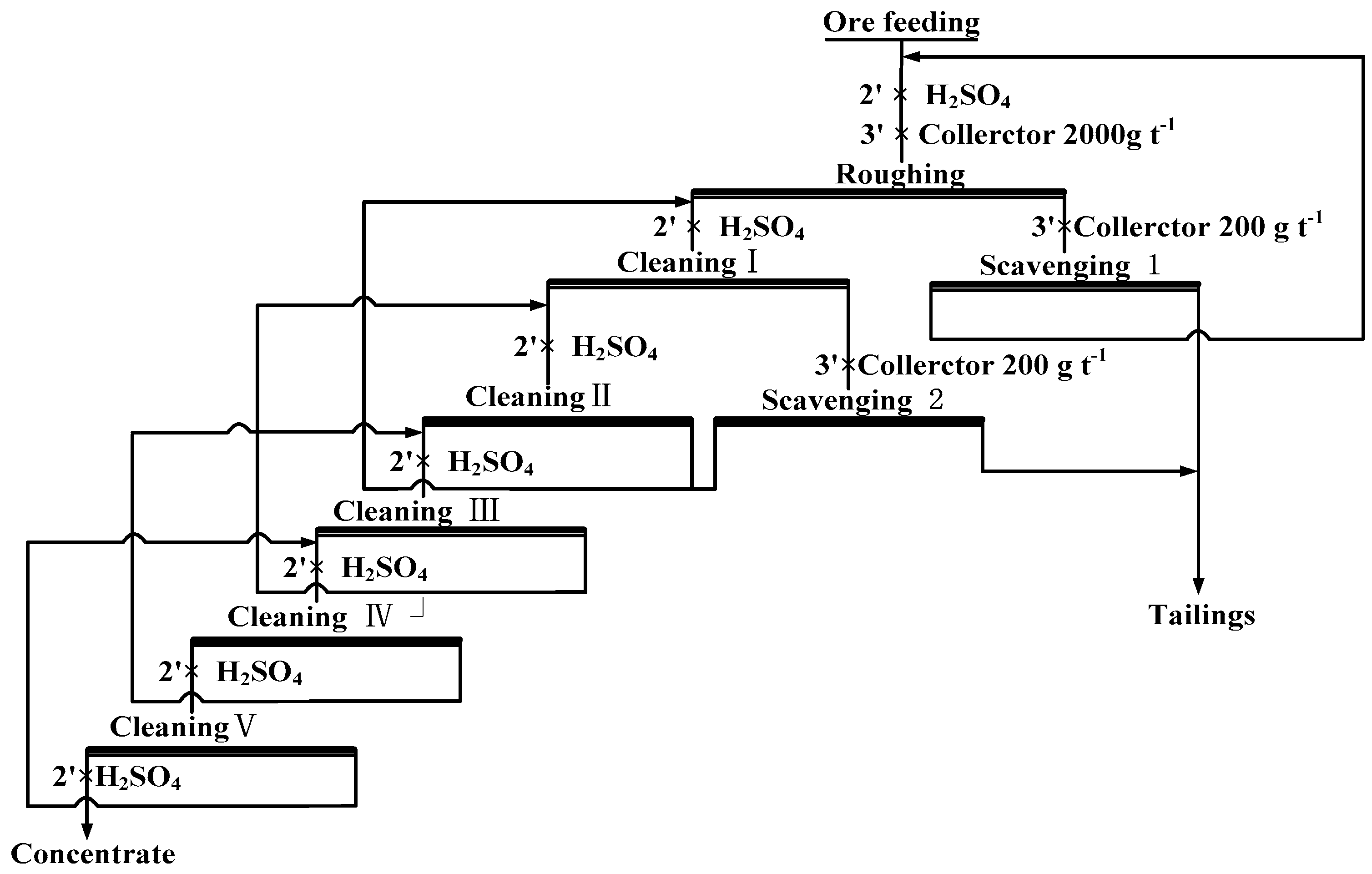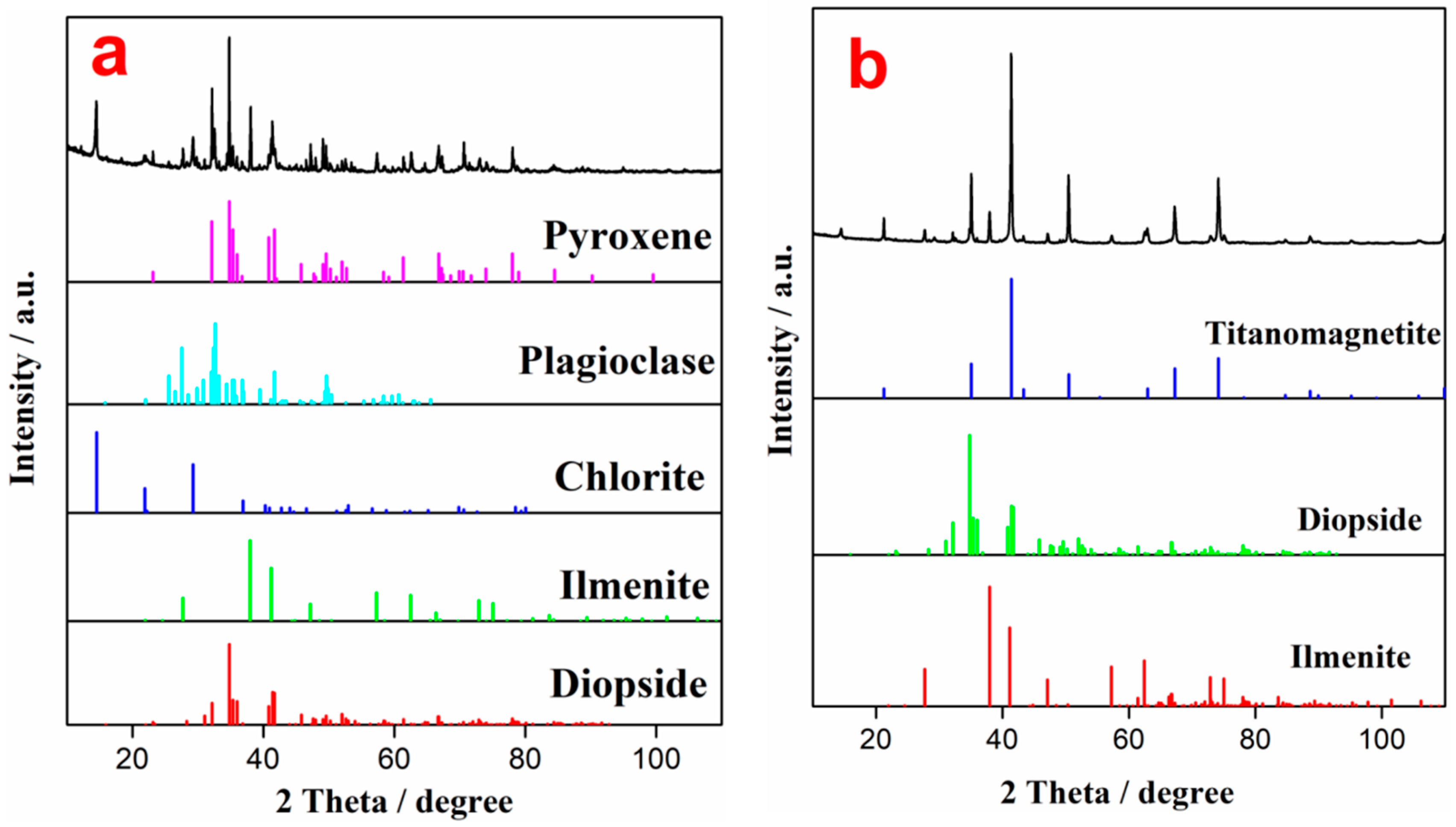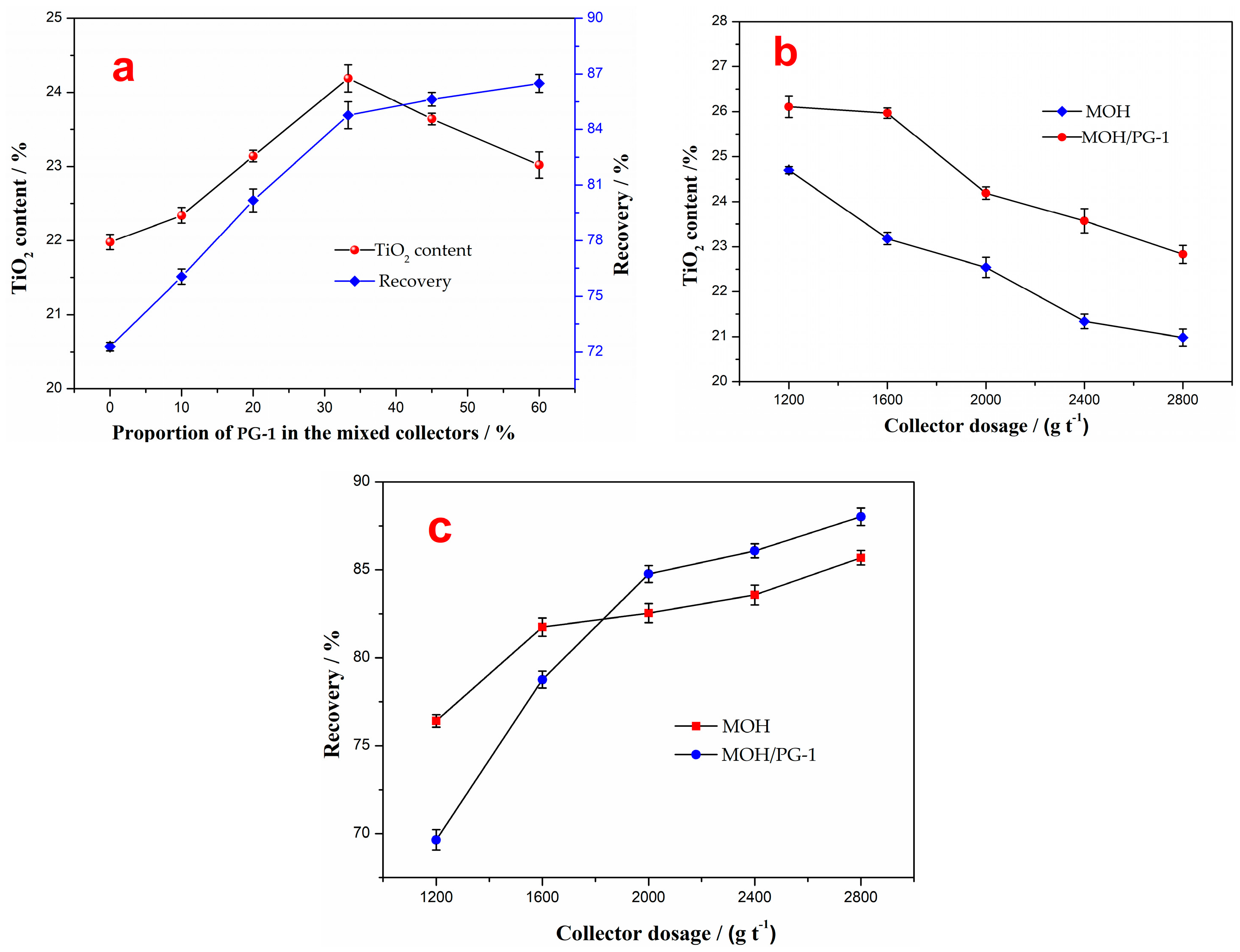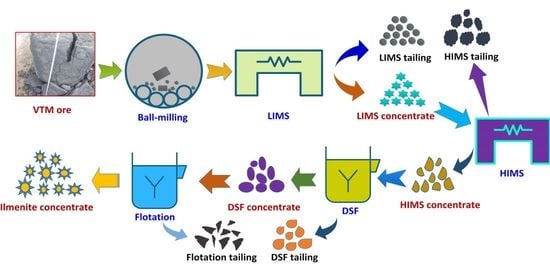3.2.2. Micro-Flotation
The effect of the proportion of the PG-1 collector in mixed collectors on the flotation concentrate was investigated at a pulp pH of 5 and for a collector amount of 2000 g t
−1, and the results are shown in
Figure 4a. It can be seen from the figure that as the proportion of PG-1 in the mixed MOH/PG collectors increases, the TiO
2 content of the flotation concentrate first increases and then decreases, while the recovery increases, indicating that the collection effect of the mixed MOH/PG-1 collectors is stronger than that of MOH. However, an excessive amount of PG-1 leads to a significant decline in the TiO
2 grade, resulting in a poor separation of ilmenite and the gangue minerals. Therefore, the best proportion of PG-1 in the mixed MOH/PG-1 collectors is 33.3%, at which the TiO
2 content and recovery of the flotation concentrate are 24.19% and 84.77%, respectively.
The influence of the collector dosage on the flotation of ilmenite was studied for a proportion of PG-1 in the mixed collectors of 33.3% and a pH of 5, and the results were compared with the case in which the MOH collector was used. The results show that with the increase in the amount of the mixed collector, the TiO
2 content of the flotation concentrate decreases while the recovery gradually increases (
Figure 4b,c). For the same amount of collector, the TiO
2 content of the concentrate obtained using the mixed MOH/PG-1 collectors is around 1.5% higher than that obtained using the MOH collector. When the amount of the collector is less than 1600 g t
−1, the recovery of the flotation concentrate obtained using the MOH collector is higher than that obtained using the mixed MOH/PG-1 collectors. However, the recovery of the former becomes lower than that of the latter once the amount in the collector is increased to 2000 g t
−1. It should be noted that reducing the amount of collector is beneficial to improving the grade of the flotation concentrate. However, the recovery is relatively low, and there is still a large amount of ilmenite remaining in the flotation tailing. When the amount of the collector is 2000 g t
−1, the recovery of the flotation concentrates obtained using the MOH and MOH/PG-1 collectors is 82.54% and 84.77%, respectively. The increase in the recovery is considerably lower than the decrease in the TiO
2 content upon continually increasing the amount of the collector. Therefore, the amount of the mixed collector was selected to be 2000 g t
−1.
To further analyze the influence of the mixed MOH/PG-1 collectors on the ilmenite separation, the flotation concentrate obtained using a collector amount of 2000 g t
−1 was investigated via FTIR. It can be seen from
Figure 5 that there are seven typical absorption peaks of the MOH collector in the wavenumber range of 400–4000 cm
−1; in particular, the peak at 3440 cm
−1 is the stretching vibration of the O–H bond, and the peaks at 2924 and 2853 cm
−1 are the vibration absorption peaks of the C–H bond [
37,
38]. The asymmetric stretching and symmetric vibration absorption peaks of the C=O group are observed at 1563 and 1451 cm
−1, respectively, while the rocking vibration absorption peaks of the long carbon chain are observed at 726 and 693 cm
−1 [
39,
40]. In the infrared spectrum of the mixed MOH/PG-1 collectors, in addition to the absorption peak of the MOH collector, four characteristic peaks can be observed at 1230, 1099, 978, and 822 cm
−1; the two former peaks are the stretching vibration absorption peaks of the C–N and N–O bonds, respectively, while the two latter peaks are the long carbon chain vibration absorption peaks of PG-1 [
41,
42]. With the addition of the PG-1 collector, the characteristic absorption peaks of MOH located at 1563, 1451, 726, and 693 cm
−1 become more intense, which indicates that these groups are more easily adsorbed on the surface of ilmenite. When the MOH collector interacts with ilmenite, the typical absorption peaks of the ilmenite concentrate appear at 3440, 2367, 2332, and 1632 cm
−1. Compared with the MOH collector, it can be seen that the vibration absorption peak of the C=O group of the mixed MOH/PG-1 collectors is shifted by 69 cm
−1 toward a higher wavenumber. This indicates that the MOH collector is chemisorbed on the surface of ilmenite, but the shift of the O–H characteristic peak is not clear; it may be caused by the physical adsorption of the collector and ilmenite [
14]. In addition, the vibration absorption peaks at 2367 and 2332 cm
−1 may be caused by the CO
2 adsorption on the sample surface [
43]. When the mixed MOH/PG-1 collectors are used for flotation, in addition to the characteristic peaks of the MOH collector, the spectrum also shows the presence of characteristic peaks at 1064 and 977 cm
−1. Compared with the MOH collector, it can be seen that the N–O characteristic peak of the mixed MOH/PG-1 collectors is shifted by 35 cm
−1 toward a lower wavenumber, indicating that the mixed collector is chemisorbed on the surface of ilmenite. These results suggest that the flotation effect of the MOH+PG-1 collector on ilmenite is better than that of the MOH collector.
Since sulfuric acid can oxidize Fe
2+ on the surface of ilmenite to Fe
3+ with active sites and increase the floatability of ilmenite, it is often used to adjust the pH value of pulp [
44]. Therefore, the effect of different pH values on the grade and recovery of the flotation concentrate with a collector amount of 2000 g t
−1 and a proportion of PG-1 of 33.3% in the mixed collectors was investigated, and the results are shown in
Figure 6. The results show that with an increasing pH value, the TiO
2 content of the flotation concentrate decreases gradually, while the recovery first increases and then decreases. However, the mixed MOH/PG-1 collectors are superior to the MOH collector in separating ilmenite. It should be noted that a reduction in pH improves the grade of the flotation concentrate; however, this leads to an increase in the sulfuric acid reagent consumption and a reduction in the recovery. The recovery obtained using the MOH and MOH/PG-1 collectors is the highest at a pH value of 5 (82.54% and 84.77%, respectively), as shown in
Figure 6, corresponding to TiO
2 contents of 22.54% and 24.15%, respectively. Therefore, the best pH value for flotation is 5.
To further analyze the influence of the pH on the mechanism of the two collectors, the zeta potentials of the ilmenite concentrate obtained using the two collectors are shown in
Figure 7. It can be seen that the equipotential point of ilmenite without a collector is pH = 4.3, which is consistent with the results of Xu et al. (pH = 4.6) [
45]. However, the equipotential point of ilmenite is shifted considerably toward a negative value after the addition of the collector, indicating that the collector is chemisorbed on the surface of ilmenite. In particular, the shift is more pronounced for the mixed MOH/PG-1 collectors than for the MOH collector, indicating that the adsorption energy of the mixed collector on the surface of ilmenite is higher than that of the MOH collector. The Ti–O and Fe–O bonds in ilmenite are destroyed during grinding to form Ti
4+ and Fe
2+ unsaturated bonds, which can form Ti(OH)
n4−n, Fe(OH)
m2−m, and other hydroxyl complexes with OH
− or H
2O in aqueous solution [
46]. As the solubility of Fe
2+ in solution is significantly higher than that of Ti
4+, positive charge ions, such as Ti(OH)
3+, Ti(OH)
22+, and Ti(OH)
3+, can be formed on the surface of ilmenite; these cations can directly combine with the anionic collectors, resulting in the observed negative zeta potentials [
47]. In addition, since the PG-1 collector containing the hydroxamate group can form five-membered ring chelate complexes with Ti or Fe in ilmenite, the mixed MOH/PG-1 collectors are superior for ilmenite collection [
48].
3.2.3. Closed-Circuit Flotation
The results of the closed-circuit flotation experiments are shown in
Table 8. It can be seen from the table that a TiO
2 grade of 43.03% can be obtained via the closed-circuit flotation process using MOH as the collector; the corresponding yield and recovery are 23.32% and 70.7%, respectively. However, an ilmenite concentrate with a 46.34% TiO
2 content can be obtained using MOH/PG-1 as the collector; this value is 3.31% higher than that obtained using MOH, and the corresponding recovery is 1.20% higher. By contrast, the TiO
2 content of the tailing obtained using MOH+PG-1 is 0.31% lower than that obtained using MOH and can thus be neglected.
To further study the action mechanism of the collector on the surface of ilmenite, XPS measurements were performed to analyze the content of the main elements in the ilmenite concentrate obtained using the two collectors. It can be seen from
Table 9 that the C and N contents of the ilmenite concentrate obtained using the mixed MOH/PG-1 collectors are higher than those obtained using the MOH collector, indicating that both the MOH and PG-1 collectors are adsorbed on the surface of the ilmenite concentrate [
49]. The separation of ilmenite is enhanced due to the synergism between the MOH and PG-1 collectors. The chemical binding energies of the Fe 2p and Ti 2p peaks in the ilmenite concentrate obtained using the two collectors were determined through peak deconvolution to determine the type of flotation adsorption. It can be seen from
Figure 8 that the Ti 2p photoelectron spectrum of ilmenite exhibits four characteristic peaks: The characteristic peaks at 463.88 and 458.12 eV correspond to the spin–orbit–split photoelectrons of the Ti–O–Fe 2p
1/2 and Ti–O–Fe 2p
3/2 orbitals in ilmenite, while the characteristic peaks at 465.82 and 459.09 eV correspond to the Ti
4+ ions on the TiO
2(110) surface, which are labeled TiO
2 2p
1/2 and TiO
2 2p
3/2, respectively [
21]. To detect the Ti
4+ signal originating from the Ti–O–Fe bond, the Ti
4+ ions on the TiO
2 surface were labeled Ti
4+*. The Fe 2p photoelectron spectra of ilmenite shows five characteristic peaks: The characteristic peaks at 724.28 and 710.28 eV are attributed to Fe
2+ 2p
1/2 and Fe
2+ 2p
3/2, respectively; those at 730.27 and 712.06 eV represent Fe
3+ 2p
1/2 and Fe
3+ 2p
3/2, respectively; and that at 715.43 eV is a satellite peak of Fe 2p [
50]. The Ti
4+ and Ti
4+* binding energies of the ilmenite concentrate obtained using the MOH collector shift by 0.23 and 0.63 eV in the Ti 2p
3/2 spectrum, respectively, while they shift by 0.53 and 0.96 eV in the Ti 2p
1/2 spectrum, respectively (
Table 10). The change in the binding energies of both ions is greater than 0.2 eV, indicating that the MOH collector is chemisorbed on the Ti atoms of ilmenite [
51]. Similarly, the shifts in the binding energies of Ti
4+ and Ti
4+* in the Ti 2p
3/2 spectrum of ilmenite obtained using the mixed MOH/PG-1 collectors are 0.20 and 0.59 eV, respectively, and the corresponding shifts in the Ti 2p
1/2 spectrum are 0.94 and 1.39 eV, respectively, indicating that both the MOH and PG-1 collectors are absorbed on the Ti atoms of ilmenite. For the Fe atoms in the ilmenite concentrate, the Fe
2+ and Fe
3+ binding energies for the MOH collector shift by 0.30 and 0.42 eV in the 2p
3/2 spectrum, respectively, and the corresponding shifts in the Fe 2p
1/2 spectrum are 0.47 and 0.27 eV, respectively, indicating that MOH is adsorbed on the Fe
2+ and Fe
3+ ions of the ilmenite concentrate. When using the mixed MOH/PG-1 collectors, the Fe
2+ and Fe
3+ binding energies shift by 0.30 and 0.57 eV in the 2p
3/2 spectrum, respectively, and the corresponding shifts in the Fe 2p
1/2 spectrum are 0.28 and 3.30 eV, respectively. The chemisorption of the mixed collectors on Fe
3+ is enhanced compared with that of the MOH collector; the chemisorption of the mixed collectors on the Fe
3+ ions is stronger than that on the Fe
2+ ions. Therefore, the flotation capacity of ilmenite is enhanced. The above results indicate that the mixed MOH/PG-1 collectors are absorbed on the Ti
4+, Fe
2+, and especially the Fe
3+ ions of ilmenite during flotation.
